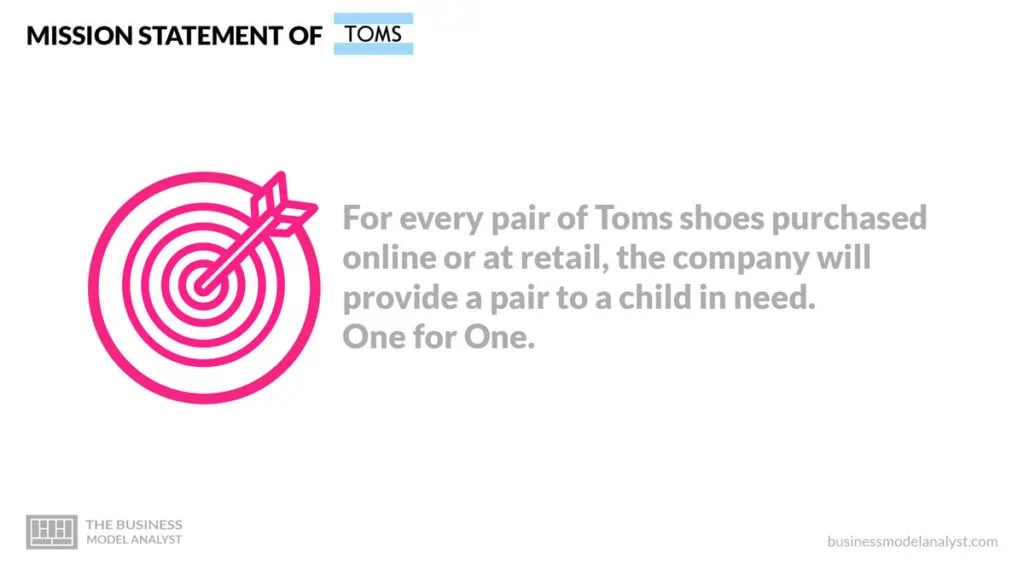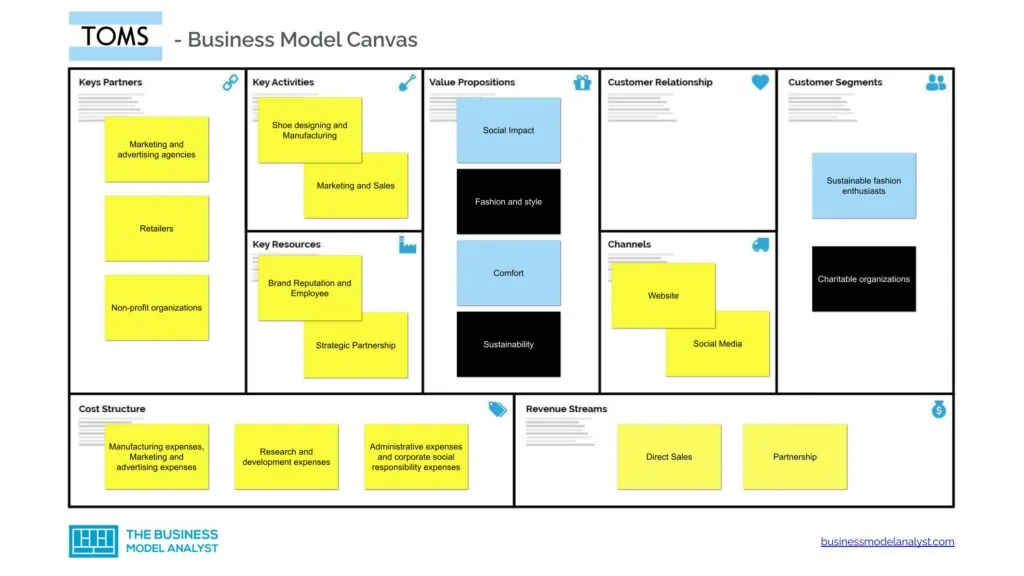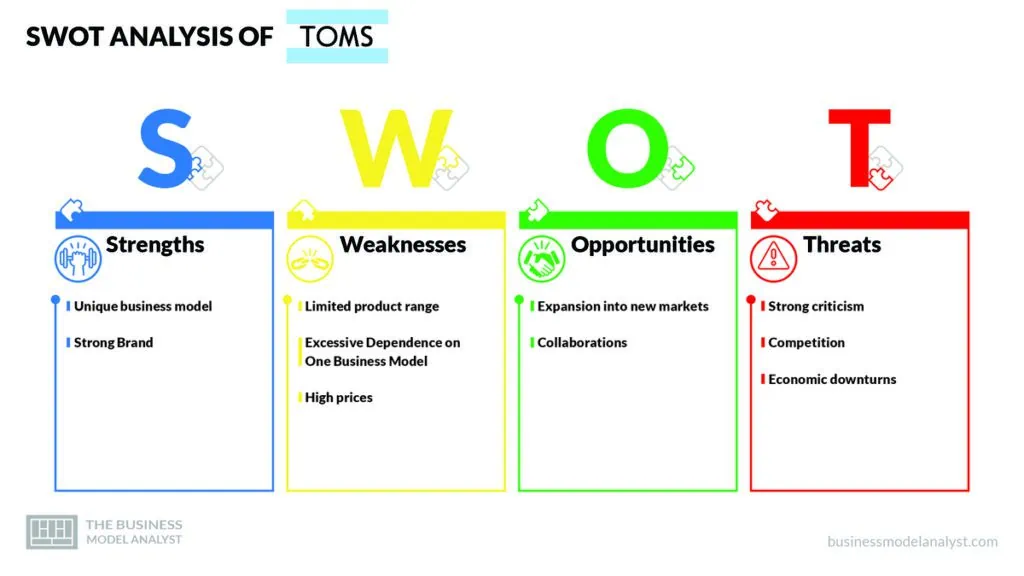The Toms Shoes Business model is one-for-one. The one-for-one business model means the company donates one pair of shoes to someone in need for every pair of shoes it sells. This unique business model was invented by Blake Mycoskie, the founder of the company, after he saw some children in Argentina who had no shoes. While this business model appears basic, it has some advantages over regular business models. The major advantage of the one-for-one model is its ability to trigger customers to market Toms Shoes’ products via word of mouth and social media.
The business model combines positive social impact with profitability. The company uses about $10 to produce a pair of shoes and sells them at $40 to $140 in stores. The difference between the production cost and selling price clearly shows that the company still makes a reasonable profit after donating a pair of shoes for every pair it sells. So far, the company has donated 35 million pairs of shoes to children in 70 countries, including Argentina, the U.S., South Africa, Ethiopia, and Rwanda.
Contents
A brief history of Toms Shoes
Blake Mycoskie, an American entrepreneur, founded Toms Shoes in 2006. Mycoskie got the idea to establish Toms Shoes when he traveled to Argentina in 2006 and realized that some children didn’t have shoes. The first Toms Shoes design was alpargata. This design is popular in Argentina, and it is simply a canvas slip-on rubber sole. At first, the company focused on donating free shoes to children in Argentina for every sale it made. Eventually, the company started expanding the regions to which it donated free shoes. The company sold 10,000 pairs of shoes in the first year of establishment. As a result, it donated 10,000 pairs of shoes to children in Argentina in October 2006. In 2007, Toms Shoes launched an annual event known as “One Day Without Shoes” to raise awareness about how shoes affect children’s lives.
In 2011, the company expanded its product portfolio by introducing eyewear. The one-for-one model still exists in other products the company sells, though the principle is slightly different. Toms Shoes company uses part of the profit it makes from eyewear sales to restore sight to someone in developing countries. Thus far, the company has successfully restored sight to over 275,000 people. The company’s product portfolio has expanded even further now as the company currently sells other products like coffee, bags, and other accessories.
Who Owns Toms Shoes
The Toms Shoes company is jointly owned by Blake Mycoskie and Bain Capital. Blake Mycoskie used to be the sole owner of the company until 2014, when a private investment firm known as Bain Capital bought 50% equity stake in Tom Shoes company. Mycoskie believes that his company needed Bain Capital as a partner to hasten the growth of the Toms Shoes company.
Toms Shoes Mission Statement

Toms Shoes’ mission statement is, “For every pair of Toms shoes purchased online or at retail, the company will provide a pair to a child in need. One for One.”
How Toms Shoes works
Toms Shoes manufactures and sells shoes, eyewear, bags, and other accessories. Toms Shoes engage in varieties of operations, including the following:
Designing and Manufacturing
Toms Shoes designs and manufactures varieties of footwear for all categories of people. Classic canvas shoes are the most common design the company manufactures. A few other types of shoes the company manufacture are sandals, boots, and wedges. The company focuses on comfort and style while making shoes.
Operates Retail and Online Stores
Toms Shoes company operates retail stores in various major cities worldwide. The stores usually display information about the beneficiary of the company’s shoe donation to further encourage its customers to support the company’s social impact efforts. Also, the company operates an online store like the physical stores.
Partners with Charity Organizations
The company works jointly with lots of charity organizations to distribute shoes freely to children who need them. The company has partnered with more than 100 organizations so that its products can reach people who need them the most.
How Toms Shoes makes money
Toms Shoes is a for-profit company despite its numerous philanthropic activities. The company generates through the following:
Direct Sales
Toms Shoes sells its products through its retail stores and online store. The direct sales method allows the company to have control over the price of its products. Also, it allows the company to build a relationship with its customers. The majority of Toms Shoes’ revenue comes from direct sales.
Via Partnership
Toms Shoes company sometimes partners with other companies to produce limited edition products. Such a partnership allows Toms Shoes to generate money from a new line of products. In addition, the partnership sometimes helps Toms Shoes reduce the money they spend on marketing and distribution. For instance, there won’t be much need to create a new distribution network when Toms Shoes partner with a company that has a well-established distribution network.
Toms Shoes Business Model Canvas
Let’s take a look at the Toms Shoes’ Business Model Canvas below:

Toms Shoes Customer Segments
Toms Shoes’ customer segments consist of:
- Sustainable fashion enthusiasts: Customers who prioritize the use of environmentally-friendly products fall within this category;
- Charitable organizations: This segment comprises non-profit organizations that partner with the Toms Shoes company.
Toms Shoes Value Propositions
Toms Shoes’ business is based on the following value propositions. For both its customer segments, they are:
- Social Impact: The company uses its one-for-one model to create positive social impacts. This value proposition appeals to customers who prioritize social impacts while purchasing;
- Fashion and style: The company designs varieties of stylish footwear so that its customers can choose from several options while shopping;
- Comfort: Toms Shoes focus on comfort while designing footwear for its customers. The materials that make up the shoe are breathable and soft, making them comfortable for a very long period without any discomfort;
- Sustainability: The company prioritizes the use of sustainable products like organic cotton, recycled materials, and eco-friendly dye. This practice helps to protect the environment and promote social responsibility.
Toms Shoes Channels
Toms Shoes’ channels consist of:
- Website
- Social Media
Toms Shoes Revenue Streams
Toms Shoes’ revenue streams consist of:
- Direct Sales
- Partnership
Toms Shoes Key Resources
Toms Shoes’ key resources consist of:
- Brand Reputation
- Employee
- Strategic Partnership
Toms Shoes Key Activities
Toms Shoes’ key activities consist of:
- Shoe designing
- Manufacturing
- Marketing
- Sales
Toms Shoes Key Partners
Toms Shoes’ key partners consist of:
- Marketing and advertising agencies
- Retailers
- Non-profit organizations
Toms Shoes Cost Structure
Toms Shoes’ cost structure consists of:
- Manufacturing expenses
- Marketing and advertising expenses
- Research and development expenses
- Administrative expenses
- Corporate social responsibility expenses
Toms Shoes Competitors
- Adidas: Adidas is a German multinational corporation that sells sports shoes, clothing, and accessories. Adidas is the second-largest producer of sportswear in the world. The company also sells casual shoes, just like Toms Shoes, which is why it is one of Toms Shoes’ biggest competitors. In fact, Adidas’s range of casual shoe styles is wider than that of Toms shoes. Adidas uses advanced technologies and materials to create stylish and durable shoes without compromising the comfort of consumers. The company even collaborated with different designers to create limited-edition shoe collections for fashion enthusiasts;
- Skechers: Sketchers is an American footwear company selling collections of casual, athletic, and lifestyle shoes. The company has been in existence since 1992 and has had great success thus far. The brand is one of Toms Shoes’ biggest competitors. It even outshone Toms Shoes and other reputable footwear brands in 2022 to win outdoor footwear brand of the year at the 2022 footwear industry awards;
- Allbirds: Allbirds is an American footwear company on a mission to create environmentally friendly footwear. The company shares several similarities with Toms Shoes. Both companies emphasize sustainability, social impacts, and comfort. Allbirds partnered with environmental organizations to reduce its carbon footprint to the lowest level possible. Like Toms Shoes, Allbirds has a very strong online presence and uses social media marketing to its advantage;
- Warby Parker: Warby Parker is an American company that manufactures and sells eyewear. The company came into existence in 2010 as an online retailer, but it now has physical retail stores in various parts of the U.S. and Canada. Its eyewear products compete keenly with Toms Shoes eyewear products in the U.S. and Canada. Warby Parker also has a strong social mission, like Toms Shoes. The company operates a “buy one, give” business model that works exactly like the one-for-one model. The company is committed to donating a pair of glasses to someone in need for every pair of glasses it sells. The company’s “buy one, give” model isn’t the only strategy the company uses to attract customers. The company’s “Home-Try-On program” is another strategy that has helped the company to stay ahead of most of its competitors in the eyewear industry. The “Home-Try-On program” allows customers to select five frames that they can try on at home for a 5-day period before they even pay any amount for the product.
Toms Shoes SWOT Analysis
Below, there is a detailed SWOT analysis of Toms Shoes:

Toms Shoes Strengths
- Unique business model: The one-for-one business model that the company utilizes makes it unique. The idea resonates well with customers who are willing to make positive impacts on the world;
- Strong Brand: The company has a strong identity in almost all parts of the world. People know Toms Shoes company to be a reputable brand that prioritizes sustainability and social responsibility. Thus far, the company has been able to gather lots of loyal customers as a result of its reputation and fame.
Toms Shoes Weaknesses
- Limited product range: Although Toms Shoes has diversified its range of products recently, the company focuses excessively on footwear. The practice limits the amount of revenue the company generates from other products. The company needs to expand its product portfolio further and make sure each of its products performs well in the market;
- Excessive Dependence on One Business Model: The one-for-one business model is the only model Toms Shoes currently utilizes. This practice may have negative consequences on the company when market conditions or customers’ preference changes significantly;
- High prices: The prices of Toms Shoes products, especially footwear, are higher than the prices of products from its competitors. The company needs to find ways to reduce the prices of its products to attract more customers.
Toms Shoes Opportunities
- Expansion into new markets: There are still some parts of the world where Toms Shoes doesn’t operate yet. The company needs to expand to those areas to generate more revenue. Also, Toms Shoes can introduce new products lines to get into new markets;
- Collaborations: Toms Shoes has the opportunity to collaborate with several reputable brands to expand the products it offers. Its reputation can be a major factor in securing profitable collaborations.
Toms Shoes Threats
- Strong criticism: Toms Shoes has a significant number of critics in several parts of the world. The critics believe that Toms Shoes’ one-for-one model disrupts local economies. It is also widely believed that Toms Shoes can use the money they spend on donating free shoes to solve bigger societal problems like hunger. If Toms Shoes keeps getting strong criticism, people may eventually stop purchasing the company’s products like they are doing currently;
- Competition: Other established footwear brands have the potential to push Toms Shoes Products out of the market. Thus far, Toms Shoes has remained relevant only because it continues to introduce new styles of shoes. If the company relents in its research and development, its market share will reduce greatly as a result of competition;
- Economic downturns: Economic downturns can force customers to stop patronizing companies like Toms Shoes selling higher-priced products. Such downturns will affect the company’s ability to expand.
Conclusion
Toms Shoes business model resonates well with many fashion consumers around the world. The company’s unique model demonstrates that it is possible to make high profits while making positive social impacts. Clearly, the one-for-one business model has helped Toms Shoes company to succeed beyond the level most people thought was possible for a company that emphasizes charity.
However, it’s important to note that the one-for-one business model has high implementation costs. The company needs to adopt additional models rather than just one business model, which seems unsustainable in the long run.

